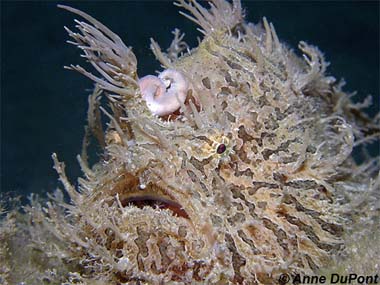
Antennarius striatus
This strange looking fish is a master ant camouflage. Within a few weeks it can completely change its color to match its surroundings. The frogfish’s illicium rod (front most dorsal fin spine) is topped with worm-like lure appendages that can regenerate if lost. It sits very still and twitches its ‘rod and lure’ to attract prey, and then quickly gulps them up. It can swallow something almost twice its own size.
Order – Lophiiformes
Family – Antennariidae
Genus – Antennarius
Species – striatus
Common Names
English language common names are striated frogfish, black angler, blotched anglerfish, spitlure frogfish, striate anglerfish, striped angler, striped anglerfish, and striped frogfish. Other common names include buchi-izariuo (Japanese), guaperva (Portuguese), izariuo (Japanese), karasu-izariuo (Japanese), kertatok (Malay), kuro-izariuo (Japanese), laffe cinq doigts (Creole/French), peixe-pescador (Portuguese), peixe-sapo (Portuguese), pescador (Spanish), ppal-gan-ssin-beng-i (Korean), ranisapo estriado (Spanish), shima-izariuo (Japanese), streep-hengelaar (Afrikaans), stribet tudsefish (Danish), and tokoklo (Fon GBE).
Importance to Humans
Frogfish are favorite subjects that are often photographed by underwater photographers. The species is a delight to see in the wild, but it takes a very good observer to pick out a frogfish because of its camouflage.
Conservation
The striated frogfish has not been evaluated by the World Conservation Union (IUCN). The IUCN is a global union of states, governmental agencies, and non-governmental organizations in a partnership that assesses the conservation status of species.
> Check the status of the striated frogfish at the IUCN website.
Geographical Distribution
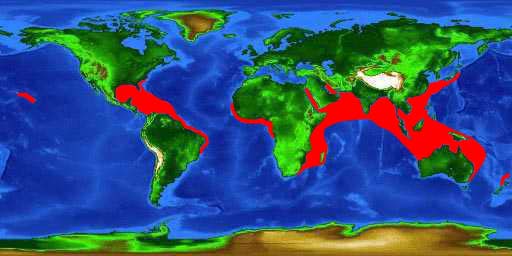
The striated frogfish is found in the eastern Atlantic Ocean off the coast of Africa from Senegal to Southwest Africa including a single record from St. Helena. In the western Atlantic Ocean, this species is found from New Jersey (US), Bermuda, Bahamas, Gulf of Mexico and throughout the Caribbean to the southern portion of Brazil. It is also found in the Indo-Pacific including the Red Sea and the East African coast to the Society and Hawaiian Islands, north to Japan and south to Australia and New Zealand.
Habitat
A subtropical benthic species, the striated frogfish resides in rocky, sandy, and rubble habitats as well as coral reefs. Along the east coast of southern Africa, it is found in shallow estuaries. This frogfish lives at depths of 33-718 feet (10-219 m) however it is more typically found to depths of 130 feet (40 m). It has been observed to inflate itself similar to the puffer fishes.
Biology
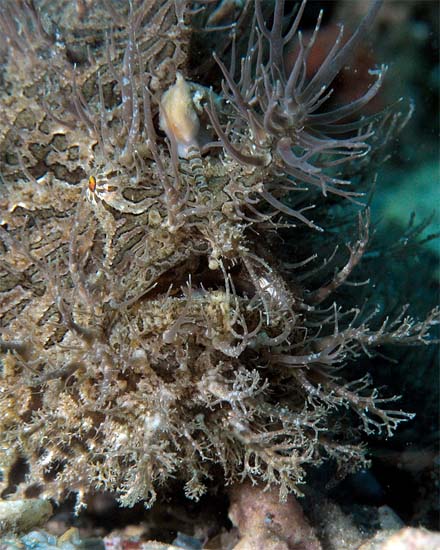
Distinctive Features
The striated frogfish has a stocky appearance and has a body that is high-backed and scaleless, being covered instead with bumpy bifurcated spinules. Males have more extended cutaneous appendages on the body than do females. The mouth is upturned with palatal teeth. Frogfish lack typical dorsal fins, instead they have three fins of which the front-most is referred to as the illicium or “rod” which is topped with the esca or the “lure”. This species has from 2-7 worm-like appendages forming the esca which can be regenerated if lost. There is a bone supporting the illicium extends in front of the upper lip. The gill openings are small and round, located just behind the pectoral fins. The gas bladder is used to control buoyancy.
A similar species, Antennarius hispidus may be distinguished from the striated frogfish by its esca or lure which is a large oval shaped tuft rather than worm-like in appearance.
Coloration
The color of the striated frogfish is extremely variable including light yellow, orange, green gray or brown with or without black stripes or elongate blotches which are sometimes solid black. There are prominent lines radiating from the eyes.
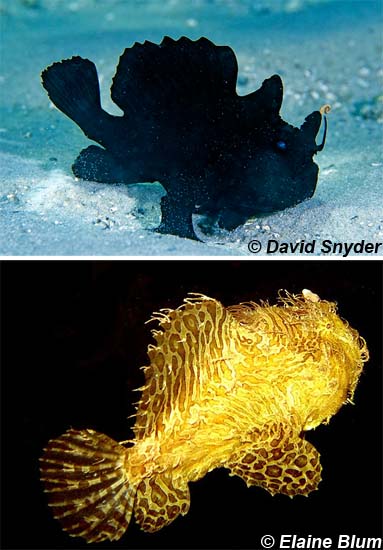
Size, Age, and Growth
The maximum reported length of the striated frogfish is 9.8 inches (25.0 cm) total length (TL), however this species more commonly reaches a length of 4 inches (10.0 cm) TL.
Food Habits
Striated frogfish feed on crustaceans and various benthic fishes such as flounders, shrimp gobies and of particular note, the lionfish which is an invasive species with the distribution range of this frogfish. Feeding behavior is quite unique in this group of fishes. When the frogfish detects its prey, it follows the movement of the prey item with its eyes. As the prey approaches, the frogfish begins to move its illicium in such a way that the esca mimics the movements of the organism it resembles which in this case is a worm. The frogfish slowly prepares for the surprise attack on the prey by stalking it or just adjusting its mouth in anticipation. The prey is actually caught via the sudden opening of the jaws which increases the mouth size up to 12 times, pulling in the prey along with water in just six milliseconds. This water flows out through the gills while the prey is swallowed and the esophagus is closed with a specially adapted muscle to keep the victim contained. Frogfish can also expand their stomachs to swallow animals up to twice their own size!
Reproduction
A unique feature of the frogfish family is that the extruded eggs are encapsulated in a ribbon-like buoyant mass of mucus, referred to as an “egg raft.” This structure may serve as a means of transporting a large number of eggs over large geographical distances. Immediately prior to spawning, the male and female march across the bottom, with the female in front and male close behind. The male’s snout is usually in immediate contact with her vent. The female is bloated with eggs during this time, often swelling to twice her normal size. The pair dashes to the surface where the egg mass is expelled from the female while the male releases gametes. The frogfish may spawn several times over the next few weeks.
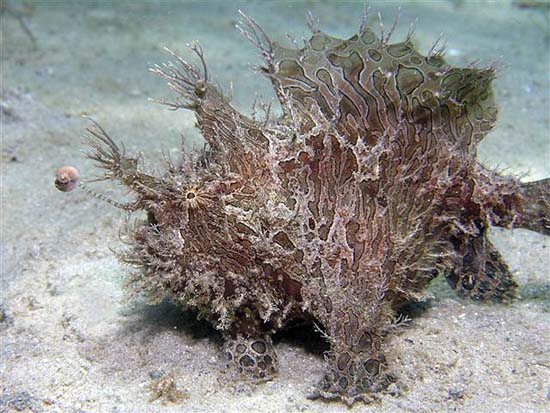
Predators
Frogfish are preyed upon by other frogfish and moray eels however this is considered an uncommon occurrence. Young frogfish may fall victim to opportunistic predators including fishes.
Taxonomy
The striated frogfish was originally described as Antennarius striatus by Shaw in 1794. It is a member of the family Antennaridae which includes the frogfishes, also known as anglerfishes in Australia. The family and genus names are derived from the Latin “antenna, antemna” meaning appendage on the head referring to the fish’s lure. The species namestriatus refers to striped color pattern of this fish. Synonyms referring to this species in past scientific literature includeChironectes scaber Cuvier 1817, Phrynelox scaber Cuvier 1817, Lophius tricornis Cuvier 1817, Antennarius scaberCuvier 1817, Chironectes tricornis Cloquet 1817, Antennarius tridens Temminck & Schlegel 1845, Phrynelox tridensTemminck & Schlegel 1845, Chironectes tridens Temminck & Schlegel 1845, Phrynelox tigris Poey 1852, Antennarius tigris Poey 1852, Chironectes tigris Poey 1852, Lophius spectrum Gronow 1854, Antennarius lacepedi Bleeker 1856, Antennarius pinniceps pinniceps Bleeker 1856, Antennarius pinniceps Bleeker 1856, Phrynelox melas Bleeker 1857, Antennarius melas Bleeker 1857, Antennarius pinniceps bleekeri Günther 1861, Saccarius lineatus Günther 1861, Antennarius pinniceps fasciata Steindachner 1866, Phrynelox nuttingi Garman 1896, Antennarius nuttingii Garman 1896, Antennarius nuttingi Garman 1896, Phrynelox nox Jordan 1902, Antennarius nox Jordan 1902, Antennarius teleplanus Fowler 1912, Antennarius cubensis Borodin 1928, Phrynelox cunninghami Fowler 1941, Antennarius cunninghamiFowler 1941, Antennarius glauerti Whitley 1944, Triantennaus zebrinus Schultz 1957, Phrynelox zebrinus Schultz 1957, Phrynelox atra Schultz 1957, Antennarius zebrinus Schultz 1957, Antennarius fuliginosus Smith 1957, Antennarius atra Schultz 1957, Antennarius occidentalis Cadenat 1959, Antennarius delaisi Cadenat 1959, and Phrynelox lochites Schultz 1964.
Prepared by: Cathleen Bester